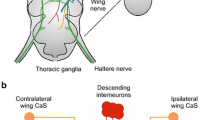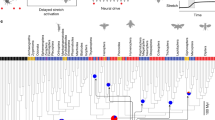Abstract
During tethered flight in Drosophila melanogaster, spike activity of the second basalar flight-control muscle (M.b2) is correlated with an increase in both the ipsilateral wing beat amplitude and the ipsilateral flight force. The frequency of muscle spikes within a burst is about 100 Hz, or 1 spike for every two wing beat cycles. When M.b2 is active, its spikes tend to occur within a comparatively narrow phase band of the wing beat cycle. To understand the functional role of this phase-lock of firing in the control of flight forces, we stimulated M.b2 in selected phases of the wing beat cycle and recorded the effect on the ipsilateral wing beat amplitude. Varying the phase timing of the stimulus had a significant effect on the wing beat amplitude. A maximum increase of wing beat amplitude was obtained by stimulating M.b2 at the beginning of the upstroke or about 1 ms prior to the narrow phase band in which the muscle spikes typically occur during flight. Assuming a delay of 1 ms between the stimulation of the motor nerve and muscle activation, these results indicate that M.b2 is activated at an instant of the stroke cycle that produces the greatest effect on wing beat amplitude.
Similar content being viewed by others
References
Batschelet E (1981) Circular statistics in biology. Academic Press, London New York
Bergmann-Erb D, Heide G (1990) Kontraktionsmodus direkter Flugsteuermuskeln von Calliphora. In: Eisner N, Roth G (eds) Brain-Perception-Cognition. Thieme, Stuttgart, p 41
Dickinson MH, Lehmann F-O, Götz KG (1993) The active control of wing rotation by Drosophila. J Exp Biol 182: 173–189
Egelhaaf M (1989) Visual afferences to flight steering muscles controlling optomotor responses of the fly. J Comp Physiol A 165: 719–730
Ewing AW (1977) The neuromuscular basis of courtship song in Drosophila: The role of the indirect flight muscles. J Comp Physiol 119: 249–265
Ewing AW (1979a) The neuromuscular basis of courtship song in Drosophila: The role of the direct and axillary wing muscles. J Comp Physiol 130: 87–93
Ewing AW (1979b) The role of feedback during singing and flight in Drosophila melanogaster. Physiol Entomol 4: 329–337
Friedrich RW, Spatz H-C, Bausenwein B (1994) Visual control of wing beat frequency in Drosophila. J Comp Physiol A 175: 587–596
Götz KG (1968) Flight control in Drosophila by visual perception of motion. Kybernetik 4: 199–208
Götz KG (1983a) Genetic defects of visual orientation in Drosophila. Verb Dtsch Zool Ges 1983: 83–99
Götz KG (1983b) Bewegungssehen und Flugsteuerung bei der Fliege Drosophila. In: Nachtigall W (ed) Insect flight II. Biona report 2. Fischer, Stuttgart, pp 21–34
Götz KG (1987) Course-control, metabolism and wing interference during ultralong tethered flight in Drosophila melanogaster. J Exp Biol 128: 35–46
Götz KG (1989) Search and choice in Drosophila. In: Singh RN, Strausfeld NJ (eds) Neurobiology of sensory systems. Plenum Press, New York, pp 139–153
Götz KG, Hengstenberg B, Biesinger R (1979) Optomotor control of wing beat and body posture in Drosophila. Biol Cybern 35: 101–112
Heide G (1971a) Die Funktion der nicht-fibrillären Flugmuskeln bei der Schmeißfliege Calliphora. I. Lage, Insertionsstellen und Innervierungsmuster der Muskeln. Zool Jb Physiol 76: 87–98
Heide G (1971b) Die Funktion der nicht-fibrillären Flugmuskeln bei der Schmeißfliege Calliphora. II. Muskuläre Mechanismen der Flugsteuerung und ihre nervöse Kontrolle. Zool Jb Physiol 76: 99–137
Heide G (1975) Properties of a motor output system involved in the optomotor response of the flies. Biol Cybern 20: 99–112
Heide G (1978) Proprioceptorische Beeinflussung der Impulsmusterbildung in neuromotorischen System fliegender Dipteren. Verh Dtsch Zool Ges 1978: 256
Heide G (1979) Proprioceptive feedback dominates the central oscillator in the patterning of the flight motoneuron output in Tipula (Diptera). J Comp Physiol 134: 177–189
Heide G (1983) Neural mechanism of flight control in Diptera. In: Nachtigall W (ed) Insect flight II. Biona report 2. Fischer, Stuttgart, pp 35–52
Heide G, Götz KG (1996) Optomotor control of course and altitude in Drosophila is correlated with distinct activities of at least three pairs of flight steering muscles. J Exp Biol (in press)
Heide G, Spüler M, Götz KG, Kamper K (1985) Neural control of asynchronous flight muscles in flies during induced flight manoeuvres. In: Gewecke M, Wendler G (eds) Insect locomotion. Parey, Berlin, pp 215–222
Heisenberg M, Wolf R (1984) Vision in Drosophila. Genetics of microbehavior. In: Braitenberg V, Barlow HB, Bullock TH, Florey E, Grüsser OJ, Peters A (eds) Studies of brain function. Springer, Berlin, pp 1–250
Hengstenberg R (1971) Das Augenmuskelsystem der Stubenfliege Musca domestica. Kybernetik 2: 56–77
Josephson RK (1984) Contraction dynamics of flight and stridulatory muscles of tettigoniid insects. J Exp Biol 114: 493–512
King DG, Tanouye MA (1983) Anatomy of motor axons to direct flight muscles in Drosophila. J Exp Biol 105: 231–239
Lehmann F-O (1994) Aerodynamische, kinematische und elektrophysiologische Aspekte der Flugkrafterzeugung und Flugkraftsteuerung bei der Fliege Drosophila melanogaster. Thesis, University of Tübingen, Germany
Lehmann F-O, Götz KG (1990) Electrical Stimulation of a flight control muscle in Drosophila. In: Elsner N, Roth G (eds) Brainperception-cognition. Thieme, Stuttgart, p 77
Lehmann F-O, Götz KG (1992) Efficiency of a flight control muscle in Drosophila depends on the phase of its spikes in the wingbeat cycle. Europ J Neurosci [Suppl] 5: 3218
Nachtigall W, Wilson DM (1967) Neuro-muscular control of dipteran flight. J Exp Biol 47: 77–97
Nalbach G (1989) The gear change mechanism of the blowfly (Calliphora erythrocephala) in tethered flight. J Comp Physiol A 165: 321–331
Pringle JWS (1949) The excitation and contraction of the flight muscles of insects. J Physiol (Lond) 108: 226–232
Pringle JWS (1965) Locomotion: Flight. In: Rockstein M (ed) The physiology of insects, vol. 2. Academic Press, New York, pp 238–329
Schrage D, Heide G (1990) Elektrische Eigenschaften von Fasern eines Flugsteuermuskels von Calliphora. In: Elsner N, Roth G (eds) Brain-Perception-Cognition. Thieme, Stuttgart, p 42
Smith DS (1965) Flight muscles in insects. Sci Amer 212(6): 76–88
Spüler M (1980) Erregende und hemmende Wirkungen visueller Bewegungsreize auf das Flugsteuersystem von Fliegen — Elektrophysiologische and verhaltensphysiologische Untersuchungen an Musca and Calliphora. Thesis, University of Düsseldorf, Germany
Tu MS, Dickinson MH (1994) Modulation of the negative work output from a steering muscle of the blowfly Calliphora vicina. J Exp Biol 192: 207–224
Tu, MS, Dickinson MH (1996) The control of wing kinematics by two steering muscles of the blowfly (Calliphora vicina) J Comp Physiol A 179: 813–830
Waldvogel F-M (1992) Flugsteuerung bei der Fliege Drosophila melanogaster: Anatomie, Muskulatur und Physiologie des Flugapparats. Thesis, University of Freiburg, Germany
Waldvogel F-M, Bausenwein B (1990) Activity of flight steering muscles in Drosophila. In: Elsner N, Roth G (eds) Brain-Perception-Cognition. Thieme, Stuttgart, p 82
Wisser A, Nachtigall W (1983) Funktionelle Gelenkmorphologie und Flügelantrieb bei der Schmeissfliege. In: Nachtigall W (ed) Insect flight I. Biona Report 1. Fischer, Stuttgart, pp 29–34
Wisser A, Nachtigall W (1984) Functional-morphological investigations on the flight muscles and their insertion points in the blowfly Calliphora erythrocephala (Insecta, Diperta). Zoomorphology 104: 188–195
Wyman R (1965) Probabilistic characterization of simultaneous nerve impulse sequences controlling dipteran flight. Biophys J 5: 447–471
Zarnack W, Möhl B (1977) Activity of the direct downstroke flight muscles of Locusta migratoria (L.) during steering behavior in flight. J Comp Physiol 118: 215–233
Author information
Authors and Affiliations
Rights and permissions
About this article
Cite this article
Lehmann, F.O., Götz, K.G. Activation phase ensures kinematic efficacy in flight-steering muscles of Drosophila melanogaster . J Comp Physiol A 179, 311–322 (1996). https://doi.org/10.1007/BF00194985
Accepted:
Issue Date:
DOI: https://doi.org/10.1007/BF00194985




